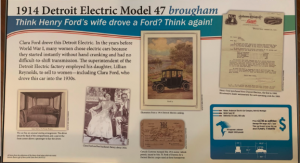How women propelled the adoption of gas and electric cars since the beginning and how they remain powerful influencers in auto purchasing
Women influence a lot when it comes to household purchasing and their impact on automobile purchases is no different.
Women have always been the influencers in the auto world, even from the beginning. The first ever automobile test drive by Bertha Benz occured in 1888 – after her husband, Carl Benz, and she created the first automobile that generated sensational buzz about the power of gasoline-powered automobiles.
The adoption of electric vehicles were also propelled by women, most notably by Clara Ford. Clara Ford’s purchase of electric car, irrespective of her husband Henry Ford’s manufacturing of gasoline cars, allowed Mrs.Ford to become an influencer and helped market the electric cars to women by showing the benefits of electric power engines over gasoline cars. Electric cars today are becoming a new norm in the auto industry, a testament to the undiminished influence of women in auto purchasing.
Despite what many people think, electric vehicles are not new. One hundred years ago Detroit Electric and Porsche made electric cars. Detroit Electric was a well-known electric brand, and one of their most prominent clients was none other than Mrs. Clara Ford. Back in that time gasoline-powered cars needed to be hand cranked to start the engine and were very messy to deal with when it came to oil leaks and exhaust gases. That is why Clara Ford, and many other women, were a fan of electric cars and overwhelmingly chose to drive them. Lillian Reynolds, daughter of the superintendent of the Detroit Electric was hired to sell cars to women.
Fast forward to the present and the influence of women and their role in auto purchasing has drastically increased. A recent trend shows auto consumers doing their research beforehand by asking for recommendations via community and auto forums before even going to car dealers. Women are also the organizers of groups and community forms on digital platforms by 60%.
From the manufacturing perspective we are seeing a shift in consumer focus towards electric cars, as they provide easy options to purchase with and fewer options to pick from , with simplified service levels, almost similar to purchasing a smartphone.How can dealers and manufacturers be prepared for the transformative shift? Well the answer is to engage as many consumers as possible, reach out to women who are the biggest influencers, be prepared to adapt to new technological tools and have marketing and sales practices that fit the modern consumer needs. Given the high propensity of women influence auto purchases, having women on a sales teams is an excellent strategy. Consumers in general find attempted car purchasing at dealerships to be very complicated. Women, especially, find it challenging to navigate the male dominated aspect of car purchasing when dealerships are involved.
Reaching to consumers via various digital platforms, when people are looking to purchase or need a solution, is the best way to engage a consumer. Businesses need to be consistent and targeted in their approach based on specific consumer needs. Therefore marketing needs to address what consumers want, rather than what businesses want to sell. Reaching out to consumers without breaching their privacy and in real-time, is a golden opportunity.
FunnelAI is all about technology adoption to new trends in marketing and sales. We help connect auto businesses to their consumers and communicate in a respectful way, maintaining the privacy of the prospective customer. We provide real-time trends in consumer interests, their needs and their preferences. Our product works for dealerships, as well as all other auto businesses and manufacturers. FunnelAI offers a very huge advantage in building engagement, long term relationships and trust with both existing and prospective customers.
Things are rapidly changing in consumer purchase preferences, both in terms of what kind of car they prefer and how they would like to buy or sell or upgrade. Therefore we need new tools to reach and engage current and future consumers on all fronts.









